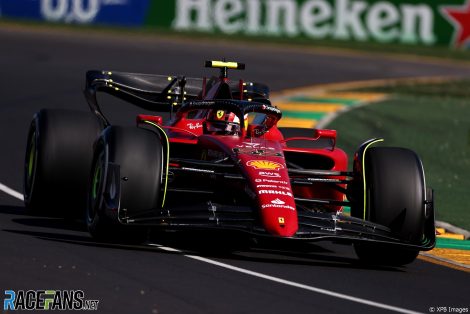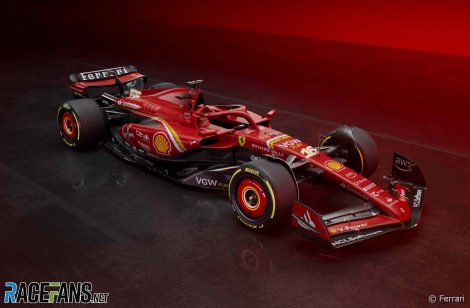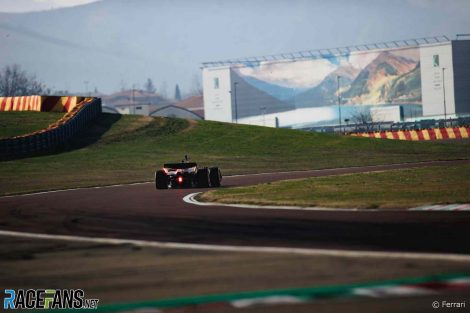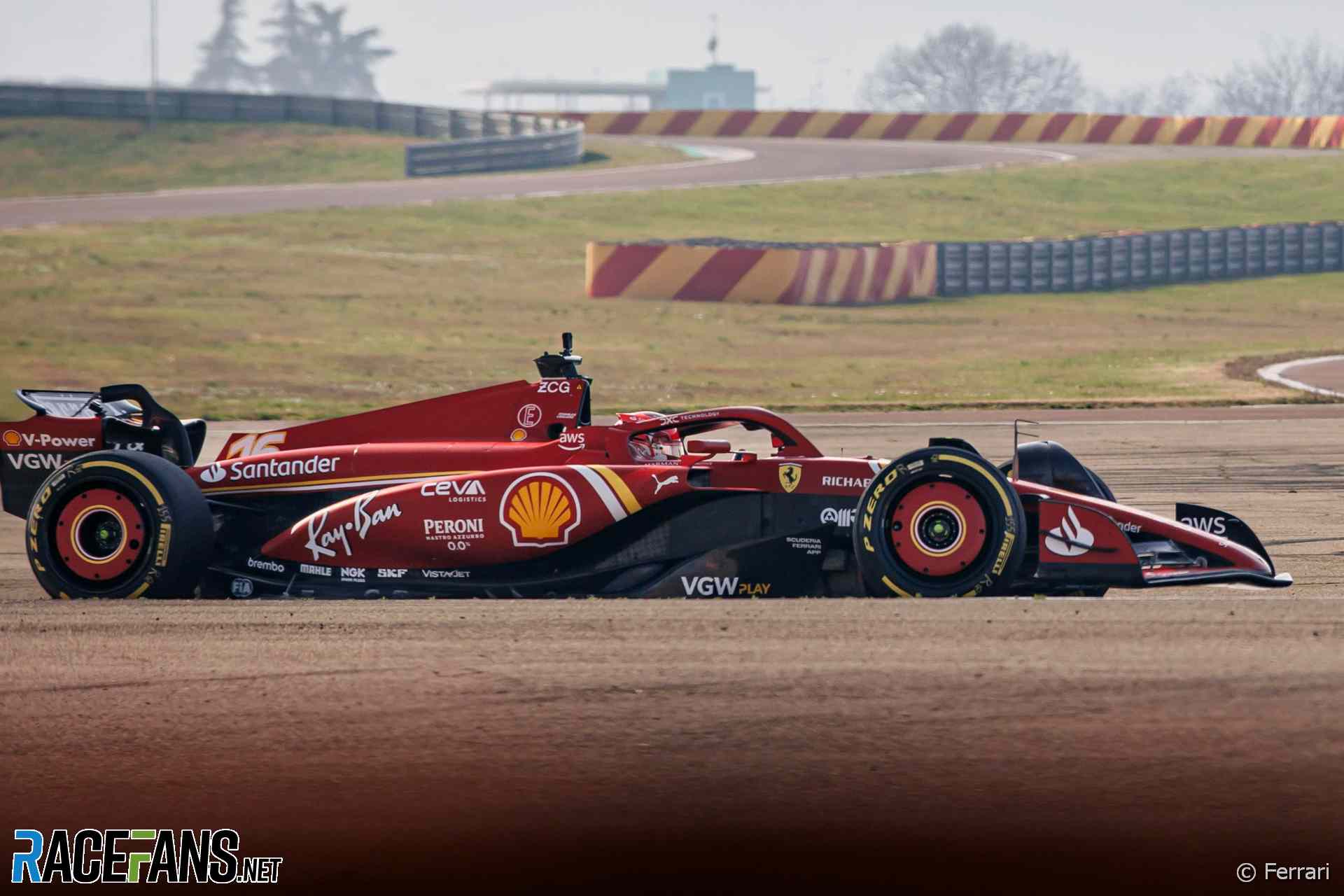Ferrari was the only team besides Red Bull to win a race last year and took five pole positions over the final nine races of the season.
So while other front-running teams like Mercedes decided early on they needed to totally overhaul their car design to get on terms with Red Bull, Ferrari wanted to retain their SF-23’s strengths while addressing its weaknesses.The SF-24, presented on Tuesday, aims to do exactly that. It is not a huge departure from last year’s car but Ferrari believe they have worked out how they can extract more potential from it and address its extreme sensitivity to changes in conditions, something they made progress with over the final races of 2023, which allowed its qualities to shine.
The team made a strong start to the current F1 rules era at the beginning of 2022. Its F1-75 won the first two races of that season and propelled Charles Leclerc into championship contention.

“I don’t think that the regulation changes affected what we did,” he told media including RaceFans. “To start with the 2022 car concept was a good one but at the end of the day, in terms of how far we could have gone with this concept was less than with the new concept.
“It was just a matter of how high is the peak of performance you can reach with that concept or with the other concept. So the 2022 car was a good car providing good performance, very stable, but when we started to add downforce to the car we strongly believed that the new concept will allow us to go more far than the previous one.”
Advert | Become a RaceFans supporter and
The team “reached a kind of asymptote on what we could do with the car” under the previous design, said Cardile, and it “was crucial to revamp the completely the architecture of the car” in order to improve the performance of its floor. Significantly, he also claimed the direction Ferrari has gone in “will be pretty common across the grid” this year.

“We tested, for a couple of years, a push-rod suspension,” Cardile explained. “In reality, our rear suspension is a bit different in terms of wishbone set-up and lower wishbone distribution compared to a Red Bull one, to mention one team. And we recorded good aero results moving towards this direction, while moving from push-rod to pull-rod we didn’t measure a big advantage as such to justify some compromise in terms of weight or compliance. So from there we evolved our suspension, keeping the same layout.”
However while “the front is pretty much a carry-over of last year in terms of concept,” Cardile says some revisions have been made to the suspension geometry at the rear of the car. “The main differences compared to last year’s car are on the rear where the suspension is differently located,” he said.
“Inside the gearbox is also a different concept which for us has been an innovation because there’s a different way to manage the inboard suspension compared to what we did in the past.”
Ferrari has also focused on improving its straight-line speed. This has meant altering many of the different rear wing trim levels it chooses from during a year based on how much downforce it requires at each track.
Advert | Become a RaceFans supporter and
“Part of the development of this year’s car has been also to revamp completely the rear wing,” said Cardile. “The car has been already presented with a new mid-downforce rear wing. We are revamping accordingly pretty much all the range we have. So we focus our attention also on the rear wings.”

“When we talk about driveability, part of the driveability is how easy it is to extract the performance, which could be done with a light car, new tyres on one single lap then becoming trickier and trickier during the race while the tyres wear, the wind changes and so on,” Cardile explained.
“So the focus of increasing the durability of the car is to have a better performance also in a race. The intention would be to put together the two worlds: Keeping being a competitive car in quali but with a platform more friendly, more exploitable also during the race, with a better performance in race.”
This has been tackled through aerodynamic changes. “The driveability content has been achieved with the aerodynamics of the car by shaping the map and giving priority to some aspects of the aerodynamics instead of others.”
However the team won’t be able to judge whether that problem has been solved without compromising the car’s single-lap performance until they have run more extensively. “What will happen with this new platform during the season in terms of compromising the quali session for the race session is something we will see when we will be on track,” Cardile concluded. “Now is too early to say if this car will be more competitive in race at than in quali like has been the past cars.”
Bringing the F1 news from the source
RaceFans strives to bring its readers news directly from the key players in Formula 1. We are able to do this thanks in part to the generous backing of our RaceFans Supporters.
By contributing £1 per month or £12 per year (or the equivalent in other currencies) you can help cover the costs involved in producing original journalism: Travelling, writing, creating, hosting, contacting and developing.
We have been proudly supported by our readers for over 10 years. If you enjoy our independent coverage, please consider becoming a RaceFans Supporter today. As a bonus, all our Supporters can also browse the site ad-free. Sign up or find out more via the links below:
Advert | Become a RaceFans supporter and





Coventry Climax
15th February 2024, 9:56
That’s an interesting thing he says there. Provided his english is correct it ‘translates’ to:
They manage their suspension – and did in the past as well – on the inboard side through some concept inside the gearbox.
With all the electronics going on, you could argue that somewhere along the drive train, their suspension is electronically managed, which is forbidden as far as I’m aware, as ‘active suspension’.
As much of it is also about aero, you could even argue it’s active aero, which is, apart from DRS, also forbidden.
Is it something the other teams do as well?
Is this yet another grey area, open for interpretation and opinion, in the FiA’s wording of the rules?
Biskit Boy (@sean-p-newmanlive-co-uk)
15th February 2024, 11:14
You could be right, but I just read it as the gearbox internals are different which means a different gearbox shape, which means different options for the suspension arrangement. When he says “manage” I think he means “configure”.
Your interpretation is more exciting!
MichaelN
15th February 2024, 14:02
This seems like a huge stretch. An active suspension is not something you can just ‘hide’ behind a bit of bodywork. It’d be super obvious that they were running one from the first video footage of the car at speed.
As it says in the preceding paragraph, Cardile is talking about the suspension geometry, and how it’s “differently located”. The changes to the gearbox allowed them to reconfigure the layout and to make all the pieces fit in a new way.
Tifoso1989 (@tifoso1989)
15th February 2024, 16:19
MichaelN
Ferrari has reduced the length of the gearbox by circa 5cm, resulting in significant changes to the suspension geometry and the overall weight distribution.
Coventry Climax
16th February 2024, 9:45
It’s not a stretch from my side, thank you.
I just -literally- read what’s -literally- being said.
The disclaimer I already used was ‘if his english is correct’. (While that should actually not even be my problem; you choose to speak english, you make sure to use it correctly, especially in a technical environment.)
This only shows how important it is to say and write things correctly; to prevent misunderstanding, speculation and controversy. Looking at you too, FiA.
Lastly, I ended -and worded- with questions, not conclusions.
Let’s just hope you’re right though, I not waiting for yet another row in F1. But they were his exact words.
Osnola
15th February 2024, 14:21
Its now
Different then last year.
Andrea Ferrero (@telegrafista)
16th February 2024, 15:00
No, I think it just means that they built a more compact gearbox which gave them room to modify the geometry of the rear suspension.
I luv chicken
15th February 2024, 13:14
I think that their translations should be taken literally, until they come up with corrected versions. We should not be left to speculate, what they were saying. In other words, I support your notion that there is something afoot in the design office.
AlanD
15th February 2024, 16:28
You really shouldn’t take things literally. Even when someone is speaking in their own language, they are trying to respond off-the-cuff to questions from journalists and they don’t necessarily use precisely the right words, and don’t realise that what they have said could be interpreted in more than one way, and when the things they said are first being interpeted by a journalist (not a lawyer) and then going through a translator into English, the nuances of what they said are often completely lost.
Coventry Climax raised a good question, Biskit Boy helped me see that there is a more rational explanation. But as with so many conspiracy theories, people seem to think there is an elaborate secret plan and yet someone forgets and blurts out the secret to the media.
Coventry Climax
16th February 2024, 10:23
AlanD, how then, when things are brought to me very serious, do I make the decision on which things to take seriously and which things not?
With all relevant scientists present, John explained to us: “We found the earth isn’t round or flat, it’s a cube.”
I expect people that explain things to the press to be exact in their words, and I expect them to realise who they are talking to, and certainly when that’s the press, that their words will be scrutinised. Especially where fields such as tech, legal, etc. are involved. When these people do not realise this, I’d say they’re unfit for the job to talk about it.
I’ll take them seriously, as I’m sure they’ll be wanting -and expecting– me to take them serious.
Likewise, when the press uses quotes and specifically writes them down as such (He said: “Always”) I expect it to be exactly what that person said. If we can’t rely on that anymore we have a big problem.
Again, the press most likely wants me to take them seriously, and I will, until they prove they’re not worth it, or unless they specifically indicate they’re not.
John wasn’t serious about the earth’s shape, by the way.
But if I hadn’t told you that here explicitly, you’d have no way to decide whether John himself would want you to take it seriously or not.
pcxmac (@pcxmac)
15th February 2024, 17:16
the car was already good, it just lacks proper floor integration and better top speed + more options for developing the tires over the period of a stint.
If Ferrari want to beat the red bull they will have to have better overall race pace, which means their tire ‘issues’ and floor need to be better placed for this year. However RBR was able to destroy just about every other team down the straight last year, I highly suspect that this will be remedied by being able to consistently push RBR off their optimization curve, and cause them to have to save more fuel and watch RBR’s race pace drop off the map when it is forced to sit behind a faster Ferrari later in a stint. How RBR is able to go faster than every other car down the straight last year, despite appearing a larger car is pretty interesting, kinda like watching the Porsche in WEC blitzing the Audi some years ago. I suspect some of that has to do with their work with Porsche and the McHonda’s misfiring system which ensures more weight on the rear right before the apex of the turn.
Nulla Pax (@nullapax)
15th February 2024, 17:38
I didn’t read the article…
Is the answer that everyone at Ferrari only listens to themselves and blames everyone else when stuff goes wrong?
Andrea Ferrero (@telegrafista)
16th February 2024, 14:57
No, it is that they are trying to improve their race pace without losing their qualification pace.